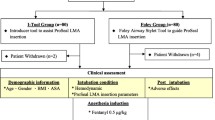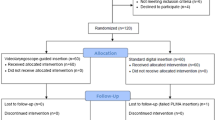Abstract
Purpose
The ProSeal™ laryngeal mask airway (PLMA™) may be difficult to insert because of its large soft cuff, even when using a dedicated introducer tool. The purpose of this study was to investigate whether introduction of a stylet (Flexi-Slip™) in the drainage tube improved insertion characteristics compared with the standard introducer.
Methods
In this randomized controlled trial, 160 adults were allocated randomly to either the Introducer group (n = 80) or to the Flexi-Slip stylet group (n = 80). In the Introducer group, the PLMA was inserted with an introducer as described in the manufacturer’s instructions. In the Flexi-Slip stylet group, a Flexi-Slip stylet was inserted into the drainage tube of the PLMA and bent to form a near 90° angle at the junction of the cuff and the airway tube. The primary outcome measurement was the success rate at first attempt. Insertion time, visible blood staining, and complications were also noted.
Results
Success at first attempt was more frequent with the Flexi-Slip stylet than with the introducer (100% vs 86%, respectively; P = 0.001). Overall time (mean ± standard deviation) taken for successful placement was shorter with the Flexi-Slip stylet than with the introducer (19.9 ± 5.6 sec vs 28.4 ± 15.2 sec, respectively; P < 0.001). The incidences of blood staining and postoperative sore throat were lower in the Flexi-Slip stylet group than in the Introducer group (4% vs 15%, respectively; P = 0.015 and 8% vs 23%, respectively; P = 0.008).
Conclusion
Insertion of the PLMA with a Flexi-Slip stylet has a higher success rate at first attempt, requires less time, and results in fewer airway complications than the introducer technique.
Résumé
Objectif
Le masque laryngé ProSeal™ (PLMA™) peut être difficile à insérer en raison de la taille de son ballonnet mou et ce, même en utilisant l’introducteur spécialement prévu à cet effet. L’objectif de cette étude était d’examiner si l’introduction d’un mandrin (Flexi-Slip™) dans le tube de drainage améliorait les caractéristiques d’insertion par rapport à l’introducteur standard.
Méthode
Dans cette étude randomisée contrôlée, 160 adultes ont été aléatoirement répartis en deux groupes, soit le groupe introducteur (n = 80) et le groupe mandrin Flexi-Slip (n = 80). Dans le groupe introducteur, le PLMA a été inséré à l’aide d’un introducteur conformément aux instructions du fabricant. Dans le groupe mandrin Flexi-Slip, un mandrin Flexi-Slip a été inséré dans le tube de drainage du PLMA et courbé afin de former un angle proche de 90° à la jonction du ballonnet et de la sonde. Le critère d’évaluation principal était le taux de réussite à la première tentative. Le temps d’insertion, les taches de sang visibles et les complications ont également été enregistrés.
Résultats
La première tentative a réussi plus souvent avec le mandrin Flexi-Slip qu’avec l’introducteur (100 % vs 86 %, respectivement; P = 0,001). Le temps global (moyenne ± écart type) nécessaire au positionnement réussi était plus court avec le mandrin Flexi-Slip qu’avec l’introducteur (19,9 ± 5,6 sec vs 28,4 ± 15,2 sec, respectivement; P < 0,001). Les incidences de taches de sang et de maux de gorge postopératoires étaient plus faibles dans le groupe mandrin Flexi-Slip que dans le groupe introducteur (4 % vs 15 %, respectivement; P = 0,015 et 8 % vs 23 %, respectivement; P = 0,008).
Conclusion
L’insertion du PLMA avec un mandrin Flexi-Slip a un taux de réussite à la première tentative plus élevé, nécessite moins de temps, et entraîne moins de complications au niveau des voies aériennes qu’une technique avec introducteur.


Similar content being viewed by others
References
Brain AI, Verghese C, Strube PJ. The LMA ‘ProSeal’—a laryngeal mask with an oesophageal vent. Br J Anaesth 2000; 84: 650-4.
Lu PP, Brimacombe J, Yang C, Shyr M. ProSeal versus the Classic laryngeal mask airway for positive pressure ventilation during laparoscopic cholecystectomy. Br J Anaesth 2002; 88: 824-7.
Brimacombe J, Keller C, Berry A. Gastric insufflation with the ProSeal laryngeal mask. Anesth Analg 2001; 92: 1614-5.
Brimacombe J, Keller C. The ProSeal laryngeal mask airway: a randomized, crossover study with the standard laryngeal mask airway in paralyzed, anesthetized patients. Anesthesiology 2000; 93: 104-9.
Brimacombe J, Keller C, Fullekrug B, et al. A multicenter study comparing the ProSeal and Classic laryngeal mask airway in anesthetized, nonparalyzed patients. Anesthesiology 2002; 96: 289-95.
Drolet P, Girard M. An aid to correct positioning of the ProSeal laryngeal mask. Can J Anesth 2001; 48: 718-9.
García-Aguado R, Vinoles J, Brimacombe J, Vivo M, Lopez-Estudillo R, Ayala G. Suction catheter guided insertion of the ProSeal laryngeal mask airway is superior to the digital technique. Can J Anesth 2006; 53: 398-403.
Howarth A, Brimacombe J, Keller C. Gum elastic bougie-guided insertion of the ProSeal laryngeal mask airway: a new technique. Anaesth Intensive Care 2002; 30: 624-7.
Chen HS, Liu PH, Chung KC. The Rusch Flexi-Slip stylet for ProSeal laryngeal mask airway insertion. Can J Anesth 2008; 55: 719-20.
Chen HS, Liu PH, Chung KC, Hung KC. Use of the Rusch Flexi-Slip stylet for patients with difficult insertion of the ProSeal laryngeal mask airway. Acta Anaesthesiol Taiwan 2010; 48: 37-40.
Kihara S, Brimacombe JR, Yaguchi Y, Taguchi N, Watanabe S. A comparison of sex- and weight-based ProSeal laryngeal mask size selection criteria: a randomized study of healthy anesthetized, paralyzed adult patients. Anesthesiology 2004; 101: 340-3.
Drage MP, Nunez J, Vaughan RS, Asai T. Jaw thrusting as a clinical test to assess the adequate depth of anaesthesia for insertion of the laryngeal mask. Anaesthesia 1996; 51: 1167-70.
LMATM Airway Instruction Manual, Revised 2005. San Diego, CA: LMA North America, Inc.; 2005.
Brimacombe J, Keller C, Judd DV. Gum elastic bougie-guided insertion of the ProSealTM laryngeal mask airway is superior to the digital and introducer tool techniques. Anesthesiology 2004; 100: 25-9.
Keller C, Brimacombe JR, Keller K, Morris R. Comparison of four methods for assessing airway sealing pressure with the laryngeal mask airway in adult patients. Br J Anaesth 1999; 82: 286-7.
Brimacombe J, Kennaugh S, Berry A, Keller C. Malposition of the ProSeal laryngeal mask (reply). Anesth Analg 2002; 94: 1367.
Brimacombe J, Keller C. Gum elastic bougie-guided insertion of the ProSeal Laryngeal Mask Airway. Anaesth Intensive Care 2004; 32: 681-4.
Kadry M, Popat M. Pharyngeal wall perforation—an unusual complication of blind intubation with a gum elastic bougie. Anaesthesia 1999; 54: 404-5.
Acknowledgement
The authors sincerely thank Mr. T. Randall Gillespie for his assistance in proofreading the manuscript.
Funding sources supporting the submitted work
Department of Anesthesiology, E-DA Hospital, Kaohsiung, Taiwan.
Conflict of interest
None declared.
Author information
Authors and Affiliations
Corresponding author
Rights and permissions
About this article
Cite this article
Chen, HS., Yang, SC., Chien, CF.C. et al. Insertion of the ProSeal™ laryngeal mask airway is more successful with the Flexi-Slip™ stylet than with the introducer. Can J Anesth/J Can Anesth 58, 617–623 (2011). https://doi.org/10.1007/s12630-011-9506-6
Received:
Accepted:
Published:
Issue Date:
DOI: https://doi.org/10.1007/s12630-011-9506-6




